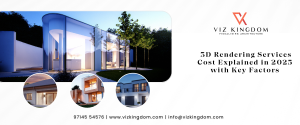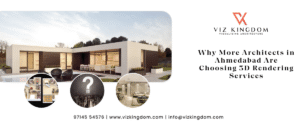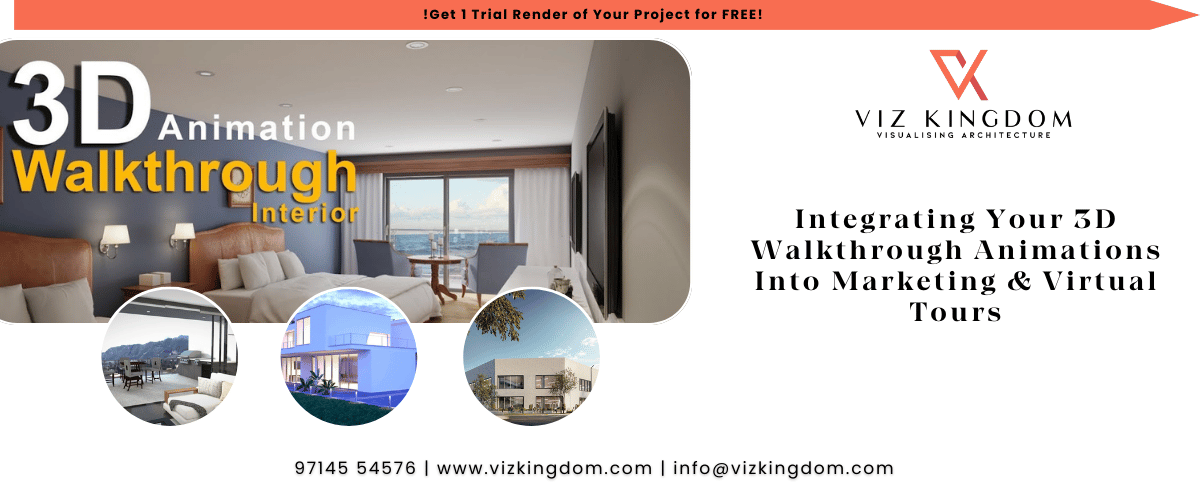
The Difference Between 3D Rendering, 3D Walkthrough, and Virtual Reality
In today’s digital-first world, visual communication is everything—especially in industries like architecture, real estate, construction, and interior design. But if you’ve ever come across terms like 3D rendering, 3D walkthrough, or virtual reality, you might be wondering—what’s the difference? Do you need all of them, or just one? And how do they fit into your project?
Let’s break it down together in simple terms so you can choose what’s right for your business.
1. What is 3D Rendering?
3D rendering is the process of creating realistic 2D images from a 3D model. These are essentially still shots—just like photographs—that visualize what your space or product will look like before it’s even built.
📌 For example: Imagine seeing a photorealistic image of your future kitchen before the foundation is even laid. That’s 3D rendering in action.
Key Features:
- High-resolution static visuals
- Can be styled to show day/night lighting
- Useful for design approvals, client presentations, and marketing
Use Cases:
- Real estate property listings
- Product visualization
- Architecture and interior design projects
👉 At Vizkingdom, we specialize in 3D rendering services in India, helping businesses across the USA tap into premium-quality visuals at a fraction of the local cost.
Quick Stat: According to Global Market Insights, the 3D rendering market is expected to surpass $9 billion by 2032, with demand rising sharply in real estate and urban planning.
2. What is a 3D Walkthrough?
While 3D rendering gives you still images, 3D walkthroughs bring those designs to life with animation.
Think of it like a virtual video tour of your space. The camera moves through the 3D model, letting viewers experience the layout, design flow, lighting, and overall feel of the space—just like walking through it in real life.
Key Features:
- Motion-based animation
- Includes background music, text overlays, and branding
- Helps investors, buyers, or clients visualize the project dynamically
Use Cases:
- Commercial and residential real estate
- Hotel and resort planning
- Institutional or retail architectural proposals
🔍 Many of our USA clients opt for 3D architectural walkthrough services to make an impression during investor meetings or property launches.
Stat Alert: A recent survey shows that 3D walkthrough videos can improve client engagement by 63% compared to static floor plans.
3. What is Virtual Reality (VR)?
Now we’re talking next-level immersion.
Virtual Reality (VR) places your audience inside the design using a VR headset or interactive software. Instead of watching a video or looking at an image, they’re navigating the space in 360°—turning their head or using a mouse to explore every corner.
Key Features:
- Fully immersive experience
- Ideal for client presentations, real estate tours, and training
- Works with VR headsets or web-based interactive tools
Use Cases:
- Architecture and interior design
- Education and training simulations
- Healthcare, defense, and manufacturing walkthroughs
At Vizkingdom, we help businesses across the U.S. elevate their presentations with cost-effective VR solutions powered by expert teams in India.
Market Insight: The U.S. virtual reality market is set to hit $22 billion by 2025, with real estate VR tours becoming more mainstream, especially post-COVID.
4. Key Differences: Rendering vs. Walkthrough vs. VR
Here’s a quick breakdown to help you decide:
| Feature | 3D Rendering | 3D Walkthrough | Virtual Reality (VR) |
| Format | Static Image | Video Animation | Immersive Interactive Tour |
| Interactivity | None | Low | High |
| Hardware Needed | None | Screen Only | VR Headset or Web Interface |
| Best For | Marketing, Listings | Presentations, Proposals | High-Impact Demos, Sales |
| Budget Requirement | Low | Medium | High |
So, if you’re launching a property listing, 3D rendering is perfect. But if you’re pitching to an investor or creating a customer experience center—VR or a walkthrough might be your game-changer.
5. Which One is Right for Your Project?
The best solution depends on your project goals, audience, and budget. Here’s a quick way to decide:
- ✅ 3D Rendering: Ideal if you need high-quality visuals quickly for marketing or internal design reviews.
- ✅ 3D Walkthrough: Great when you want to narrate a story and impress clients in presentations or social media campaigns.
- ✅ Virtual Reality: Go for it when you want to deliver a premium, tech-forward experience—especially for high-end buyers or corporate presentations.
Not sure what you need? That’s where Vizkingdom comes in. We help U.S.-based businesses make smarter visualization choices by offering world-class 3D architectural walkthrough services and affordable 3D rendering services in India.
6. Why Outsource to India from the USA?
Here’s why outsourcing 3D work to India is a strategic move for American companies:
- 🔧 Cost-effective: Save up to 60% on project costs
- 🕒 Time-zone advantage: Work gets done while you sleep
- 🎓 Skilled talent: Access world-class 3D artists and architects
- 📈 Scalability: Fast delivery, even for high-volume needs
Vizkingdom has helped hundreds of clients in the USA streamline their 3D design needs without compromising on quality or creativity.
7. Future Trends in 3D Visualization
The 3D world is evolving fast. Here are some trends to watch:
- AI-driven rendering: Speed up project delivery with machine learning
- Web-based VR: No headset required—just a browser!
- AR integration: Combine real-world views with virtual elements for hybrid experiences
Investing in 3D is no longer optional—it’s essential if you want to stay ahead.
Final Thoughts
Whether you’re a real estate agent, architect, interior designer, or builder, understanding the difference between 3D rendering, 3D walkthrough, and virtual reality can transform how you pitch, sell, and impress clients.
At Vizkingdom, we bridge the gap between quality and cost, offering 3D rendering services in India and 3D architectural walkthrough services to USA businesses looking to elevate their visual game.
📞 Ready to bring your project to life in 3D?
Let’s talk! Reach out to Vizkingdom today.
FAQ’s
1. What is the main difference between 3D rendering and 3D walkthrough?
3D rendering provides static, high-quality images of a space or object, while a 3D walkthrough is an animated video tour that simulates movement through the space. Rendering is perfect for marketing images and design approvals, whereas walkthroughs are ideal for presentations and storytelling.
2. Do I need VR equipment to use virtual reality in my business?
Not necessarily. While premium VR experiences use headsets like Oculus or HTC Vive, many virtual reality services today offer web-based VR experiences that work directly in a browser—no extra gear needed. Vizkingdom can help you choose the right format based on your audience.
3. How much does a 3D walkthrough or rendering cost?
Costs vary depending on the complexity, duration, and detail level. On average, 3D renderings can start at $250 per image, while walkthroughs might begin around $1500 for short animations. However, by outsourcing to experts like Vizkingdom in India, you can save up to 60% on production costs without sacrificing quality.
4. How long does it take to create a 3D architectural walkthrough?
Typical turnaround time for a professional 3D walkthrough ranges from 30 to 45 business days, depending on project size and revisions. Vizkingdom offers streamlined delivery timelines with overnight progress updates for our U.S. clients.
5. Can I get both rendering and walkthrough from the same provider?
Yes! At Vizkingdom, we offer complete 3D visualization packages, including 3D rendering, walkthrough animation, and VR solutions—so you get consistent quality, style, and communication throughout your project.
6. Why should I outsource 3D rendering services to India from the USA?
Outsourcing to India offers world-class talent, faster delivery, and significant cost savings. With Vizkingdom, you get a dedicated U.S.-focused project team, clear communication, and visuals that wow your clients—without stretching your budget.






